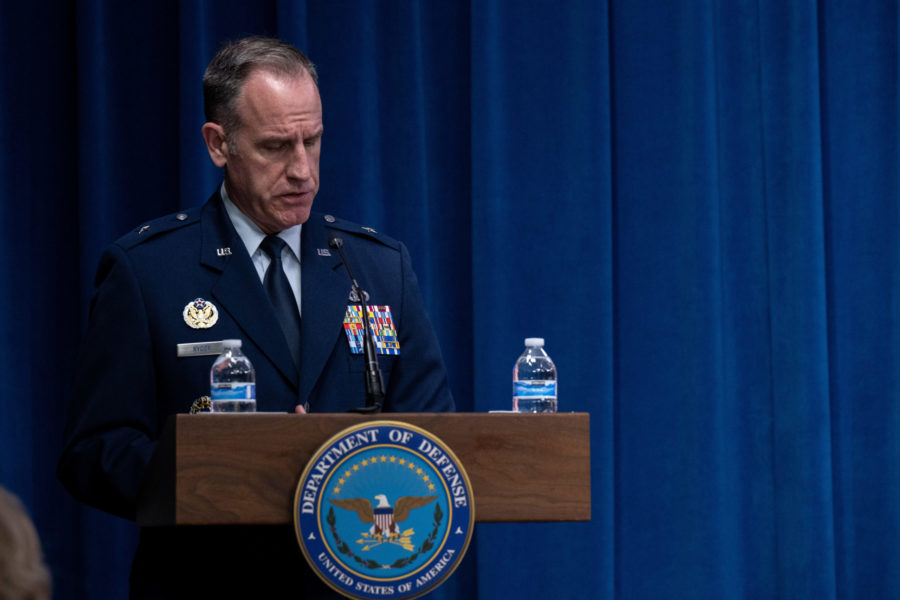The Pentagon said Aug. 25 that a battle with Iran-affiliated militants in northeastern Syria was over and that U.S. Central Command had taken measures to avoid escalation.
One U.S. service member was treated for a minor injury and returned to duty, and two others were under evaluation for minor injuries after a coordinated attack Aug. 24 in which several rockets landed inside the perimeter of Mission Support Site Conoco and in the vicinity of Mission Support Site Green Village, both in northeastern Syria.
U.S. Central Command reported Aug. 25 that it retaliated against that latest attack with AH-64 Apache attack helicopters, AC-130 gunships, and M777 artillery, killing four militants and destroying rocket launchers.
The exchange of attacks began when militants attempted to attack U.S. facilities in Syria on Aug. 15 with unmanned aerial vehicles possibly supplied by Iran.
The United States responded Aug. 23 when four F-15Es and four F-16s launched from bases in the region to fire at nine militant bunkers, avoiding militant casualties. Two additional strikes were removed from the target list when human movement was detected.
DOD denied that it had waited nearly 10 days to respond to the attack while the United States and Iran hashed out final details for Iran to rejoin the Joint Comprehensive Plan of Action (JCPOA), better known as the Iran nuclear deal. Instead, some 400 hours of intelligence was collected at the target sites.
“Separate from the JCPOA, we will defend our people no matter where they’re attacked or when they’re attacked,” said DOD Press Secretary Air Force Brig. Gen. Patrick S. Ryder.
“The two really are not interrelated in that regard,” Ryder said. “Our forces were threatened. We took appropriate and proportionate response and will do so anywhere and anytime that we receive that threat.”
The battle with Iranian-backed and supplied forces came as the United States and Iran are close to bringing Iran back into compliance with the JCPOA and lifting U.S. sanctions that were reimposed when President Donald J. Trump withdrew from the deal in 2018. The JCPOA is intended to limit Iran’s ability to produce a nuclear weapon. Since breaking away from the agreement, Iran has enriched uranium to levels consistent with the construction of a nuclear weapon.
Ryder declined to discuss the operational planning that led to the delay that occurred while JCPOA negotiations were ongoing. Ryder said Air Force intelligence, surveillance, and radar assets helped assure no militants were killed as a result of those American strikes.
“In terms of our objectives and the message we were trying to send, which was a proportional response to the [UAV] attacks against U.S. forces, none of our forces were killed,” Ryder said in response to a question from Air Force Magazine.
Ryder also drew a distinction between the decision not to target militants and the Pentagon’s Aug. 25 release of its Civilian Harm Mitigation and Response Action Plan, a wide-ranging effort to reform military doctrine and operational planning to mitigate civilian casualties.
“In this context, no, I wouldn’t conflate the two,” Ryder said. “This was a concerted decision not to strike individuals, suspected militants, because, again, we were aiming to do a proportional strike.”
UAVs Traced to Tehran
Undersecretary of Defense for Policy Colin H. Kahl said at an Aug. 24 Pentagon briefing that UAV pieces collected at the Aug. 15 attack sites were “traced directly back to Tehran.”
“We don’t want Iran to draw the wrong conclusion that they can continue just doing this and get away with it,” Kahl said at the briefing. “Our concern was that this might be an indication that Iran intends to do more of this, and we wanted to disabuse them of any sense that that was a good idea.”
The DOD policy chief said the United States has communicated through multiple channels with Iran against supporting the militants.
After the Aug. 24 rocket attacks and deadly retaliation by the U.S., Army Gen. Michael E. Kurilla, commander of U.S. Central Command, said the U.S. “will respond appropriately and proportionally to attacks on our servicemembers,” according to a press release. “No group will strike at our troops with impunity. We will take all necessary measures to defend our people.”
Ryder said the aerial response did not indicate that the battle with Iranian-backed forces was heating up.
“That does not necessarily indicate that things are escalating,” he said. “We maintain a variety of platforms in the region to provide whatever types of support we may need, and, of course, the AC-130 gunship is one of those capabilities.”
National Security Council spokesperson John Kirby said at an Aug. 24 press briefing that Iran has made concessions and that a deal to bring Iran back into compliance with the JCPOA is close.
“We are closer now than we were just even a couple of weeks ago because Iran made the decision to make some concessions,” Kirby said. “So that’s a positive step forward, but I would add very quickly … gaps remain. We’re not there.”
Drawing a distinction between the ongoing JCPOA negotiations, Ryder said the message of deterrence was conveyed in Syria.
“In terms of the strikes in Syria, again what I would say was our focus was on sending a message loud and clear to these Iran-backed militants in terms of what is not acceptable behavior, and that’s targeting U.S. forces,” he said.

